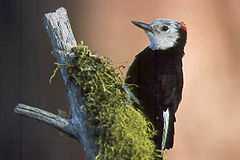Picoides
| Picoides | |
|---|---|
 | |
| White-headed woodpecker (Picoides albolarvatus) | |
| Scientific classification | |
| Kingdom: | Animalia |
| Phylum: | Chordata |
| Class: | Aves |
| Order: | Piciformes |
| Family: | Picidae |
| Subfamily: | Picinae |
| Tribe: | Dendropicini |
| Genus: | Picoides Lacépède, 1799 |
| Species | |
|
See text. | |
Picoides is a genus of woodpeckers (family Picidae) found primarily in North America. The plumage in most species is predominantly black and white, brown and white in some southern species, with the male often having a red (or yellow) badge. Their bills are straight and chisel-shaped. Although in the four-toed species, the toes normally have a zygodactyl or yoked arrangement while on the ground, one toe can be rotated forward for climbing. Some species in this genus are three-toed. All species in this genus feed mainly on insects.
Systematics
The genus is in need of revision. Two species that have a somewhat different color pattern, especially on the head and neck – the striped and the checkered woodpecker – have turned out to belong in Veniliornis, a genus most closely related to Picoides. On the other hand, the smoky-brown woodpecker (Picoides fumigatus) seems to be an early offshoot of Picoides. Its unique coloration (similar to the unrelated Okinawa woodpecker) would be an adaptation to dense forest habitat, although due to its distinctiveness it is not inconceivable that it belongs into a genus of its own and merely is a case of molecular convergence. The American three-toed woodpecker was until recently considered conspecific with the Eurasian one (Sibley & Monroe 1990), and the lesser spotted woodpecker is often placed in the genus Dendrocopos. Indeed, that genus is sometimes merged into Picoides, but this is neither generally accepted nor well supported.
Analysis of mtDNA COI and Cyt b sequences suggests that Picoides is really three genera (Moore et al., 2006). One is a group of small four-toed species and the Eurasian P. minor, whereas the other group unites the larger species and would include the smoky-brown woodpecker. The three-toed species constitute a different lineage closer to some species of Dendrocopos.
All three groups are notable for the high degree of convergent evolution in plumage patterns existing between them (Weibel & Moore, 2005; Moore et al., 2006). There are several pairs of species from different groups, which are almost alike; the most notable example is the downy and hairy woodpeckers, which are not closely related but independently evolved a plumage pattern that is identical down to minor details.
- Three-toed group (Picoides sensu stricto)
- Eurasian three-toed woodpecker, Picoides tridactylus
- American three-toed woodpecker, Picoides dorsalis
- Dark-bodied woodpecker, Picoides funebris[1]
- Black-backed woodpecker, Picoides arcticus
- Grey-capped woodpecker, Picoides canicapillus[2]
- Japanese pygmy woodpecker, Picoides kizuki[3]
- Philippine pygmy woodpecker, Picoides maculatus[4]
- Sunda pygmy woodpecker, Picoides moluccensis[5]
- Brown-capped pygmy woodpecker, Picoides nanus[6]
- Sulu pygmy woodpecker, Picoides ramsayi[7]
- Sulawesi pygmy woodpecker, Picoides temminckii[8]
References
- ↑ "Picoides funebris". International Union for Conservation of Nature and Natural Resources. Retrieved 2014-12-30.
- ↑ "Picoides canicapillus". International Union for Conservation of Nature and Natural Resources. Retrieved 2014-12-30.
- ↑ "Picoides kizuki". International Union for Conservation of Nature and Natural Resources. Retrieved 2014-12-30.
- ↑ "Picoides maculatus". International Union for Conservation of Nature and Natural Resources. Retrieved 2014-12-30.
- ↑ "Picoides moluccensis". International Union for Conservation of Nature and Natural Resources. Retrieved 2014-12-30.
- ↑ "Picoides nanus". International Union for Conservation of Nature and Natural Resources. Retrieved 2014-12-30.
- ↑ "Picoides ramsayi". International Union for Conservation of Nature and Natural Resources. Retrieved 2014-12-30.
- ↑ "Picoides temminckii". International Union for Conservation of Nature and Natural Resources. Retrieved 2014-12-30.
- Gorman, Gerard (2004). Woodpeckers of Europe: A Study of the European Picidae. Bruce Coleman, UK. ISBN 1-872842-05-4.
- Moore, William S.; Weibel, Amy C.; Agius, Andrea (2006). "Mitochondrial DNA phylogeny of the woodpecker genus Veniliornis (Picidae, Picinae) and related genera implies convergent evolution of plumage patterns" (PDF). Biol. J. Linn. Soc. 87: 611–624. doi:10.1111/j.1095-8312.2006.00586.x.
- Sibley, Charles G. & Monroe, Burt L., Jr. (1990). Distribution and Taxonomy of Birds of the World Yale University Press. ISBN 0-300-04969-2.
- Weibel, Amy C. & Moore, William S. (2005). Plumage convergence in Picoides woodpeckers based on a molecular phylogeny, with emphasis on convergence in downy and hairy woodpeckers. Condor 107(4): 797–809. doi:10.1650/7858.1 (HTML abstract)